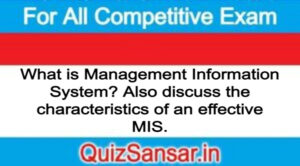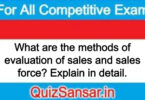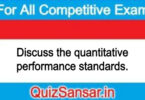
What is Management Information System? Also discuss the characteristics of an effective MIS.
What is Management Information System? Also discuss the characteristics of an effective MIS.
Ans.
Management Information System
1. MIS is a network of information that supports management decision-making.
2. MIS provides for- (a) identification of relevant information needs, (b) collection of relevant information, (c) processing of data to become useful for Managers, and (d) timely dissemination of processed information to the users of the information for managing an enterprise and taking good decisions.
3. MIS represents the “internal communications network of the business providing the necessary intelligence to plan, execute and control”. It is “structured to provide the information needed when needed and where needed”. [Frederick B. Cornish]
4. MIS is an “integrated man/machine system for providing information to support the operations, management and decision making functions in an organization”. The system utilizes computer hardware and software, manual procedures, management and decision models and a database. [G.B.Davis]
Characteristics of an Effective MIS
1. Planning: A heavy planning element must be present in MIS development. The MIS designer should keep in view future objectives and requirements of Firm’s information in mind. He must avoid the possibility of system obsolescence before its operation.
2. Management-oriented: An appraisal of management needs and overall business objectives form the basis of MIS development. It should meet the information requirements of top level, middle level and operating levels of management.
3. Management-directed: Management should actively direct the MIS’s development efforts by devoting sufficient time at all stages viz. (a) system design, (b) system review, and (c) system implementation. Management should also be responsible for setting system specifications and play a key role in the subsequent trade-off decisions that occur in system development.
4. Common data flows: Common input, processing and output procedures and media should be used whenever possible. Data should be captured by system analysts only once and very close to its original source. They should try to utilize a minimum of data processing procedures and sub-systems to process the data and strive to minimize the number of output documents and reports produced by the system. It avoids duplication, simplifies operations and produces an efficient information system.
5. Common database: Database is the “superfile” which consolidates and integrates data records formerly stored in many separate data files. The organization of a database allows it to be accessed by several information sub-systems. This will eliminate the necessity of duplication in data storage, updating, deletion and protection. In short, database cements the functional systems.
6. Integrated: All functional and operational information sub-systems should be put together into one entity. Integration means taking a comprehensive view a complete look at the or inter-dependent and inter-locking sub-systems that operate, within the Firm. An integrated MIS can generate more meaningful information to management.
7. Sub-system concept: The MIS must be broken down into digestible which can be implemented one at a time by developing a phasing plan. The breaking down of MIS into meaningful sub-systems sets the stage for phasing plan.
8. Computerized: Use of computers increases effectiveness of the MIS. Computerized MIS has the advantages of – (a) accuracy, (b) speed, (c) consistency in processing data, (d) reduction in clerical staff, and (e) ability to handle a wide variety of applications.






